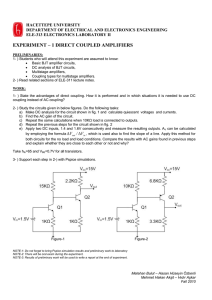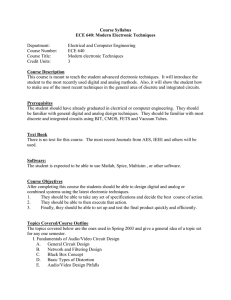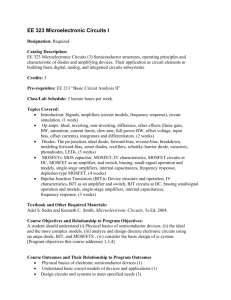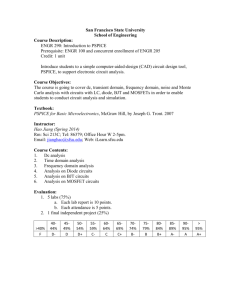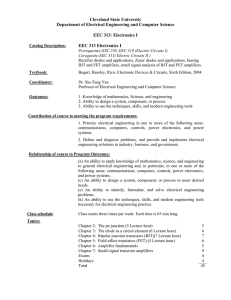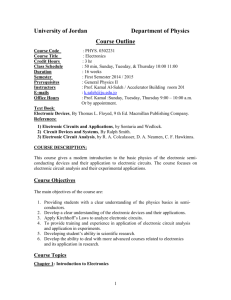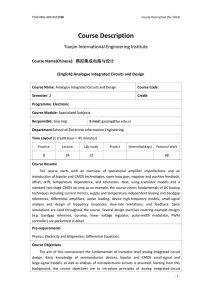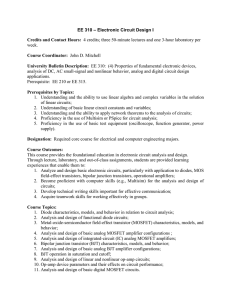Part A: Course Outline Course Title Fundamental Electronics Course
advertisement
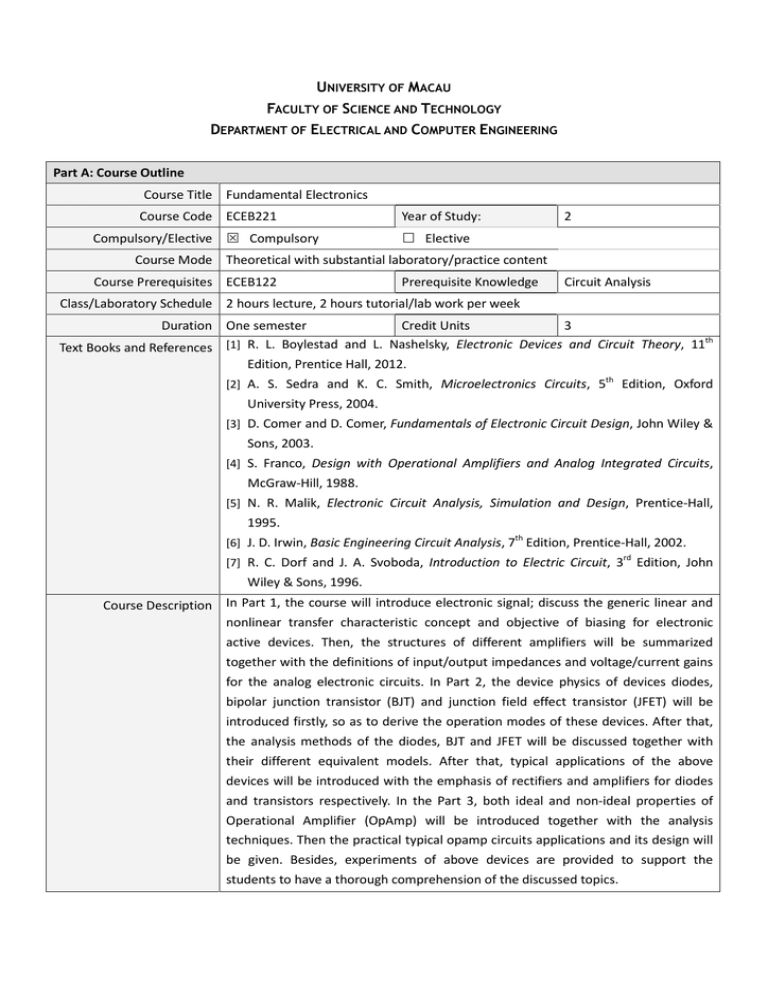
UNIVERSITY OF MACAU FACULTY OF SCIENCE AND TECHNOLOGY DEPARTMENT OF ELECTRICAL AND COMPUTER ENGINEERING Part A: Course Outline Course Title Fundamental Electronics Course Code ECEB221 Compulsory/Elective Compulsory Year of Study: 2 Elective Course Mode Theoretical with substantial laboratory/practice content Course Prerequisites ECEB122 Prerequisite Knowledge Circuit Analysis Class/Laboratory Schedule 2 hours lecture, 2 hours tutorial/lab work per week Duration One semester Credit Units 3 th Text Books and References [1] R. L. Boylestad and L. Nashelsky, Electronic Devices and Circuit Theory, 11 Edition, Prentice Hall, 2012. [2] A. S. Sedra and K. C. Smith, Microelectronics Circuits, 5 th Edition, Oxford University Press, 2004. [3] D. Comer and D. Comer, Fundamentals of Electronic Circuit Design, John Wiley & Sons, 2003. [4] S. Franco, Design with Operational Amplifiers and Analog Integrated Circuits, McGraw-Hill, 1988. [5] N. R. Malik, Electronic Circuit Analysis, Simulation and Design, Prentice-Hall, 1995. th [6] J. D. Irwin, Basic Engineering Circuit Analysis, 7 Edition, Prentice-Hall, 2002. [7] R. C. Dorf and J. A. Svoboda, Introduction to Electric Circuit, 3 rd Edition, John Wiley & Sons, 1996. Course Description In Part 1, the course will introduce electronic signal; discuss the generic linear and nonlinear transfer characteristic concept and objective of biasing for electronic active devices. Then, the structures of different amplifiers will be summarized together with the definitions of input/output impedances and voltage/current gains for the analog electronic circuits. In Part 2, the device physics of devices diodes, bipolar junction transistor (BJT) and junction field effect transistor (JFET) will be introduced firstly, so as to derive the operation modes of these devices. After that, the analysis methods of the diodes, BJT and JFET will be discussed together with their different equivalent models. After that, typical applications of the above devices will be introduced with the emphasis of rectifiers and amplifiers for diodes and transistors respectively. In the Part 3, both ideal and non-ideal properties of Operational Amplifier (OpAmp) will be introduced together with the analysis techniques. Then the practical typical opamp circuits applications and its design will be given. Besides, experiments of above devices are provided to support the students to have a thorough comprehension of the discussed topics. Topics Covered 1. Electronic signal, linear and nonlinear transfer characteristic concept, objective of biasing; 2. Characteristics of ideal and non-ideal diode; 3. Diode applications and various special diodes; 4. Basic characteristics and operation modes of BJTs and FETs; 5. Biasing of BJT and FETs circuits; 6. BJT and FET small signal model; 7. Analysis of BJT and FETs circuits at DC and AC; 8. Applications of BJTs and FETs; 9. Characteristics of both ideal and practical Op-Amp; 10. Inverting and non-inverting configuration of Op-Amp circuits; 11. Analysis of both ideal and practical Op-Amp circuits; 12. Basic circuit building blocks using Op-Amp; Course Objectives 1. To introduce the students the operational principle, models, and the analysis of diode in analog circuits together with typical applications [a, b, c, d, e, g, k, l]; 2. To study the operational principle, modes and models of BJT, analysis and different configuration of amplifiers using BJT [a, b, c, d, e, g, h, I, k, l]; 3. To study the operational principle, modes and models of BJT, analysis and different configuration of amplifiers using JFET [a, c, d, e, h, i]; 4. To introduce the students the basic properties of OpAmp, analysis and design of electronic circuits using OpAmp, [a, b, c, d, e, g, k, l]; Course Assessment Quiz: Experiments: 15% 25% Mid-term Exam : 25% Final Exam : 35% Relationship to Program This course primarily contributes to ECE program outcomes that develop students abilities to: Objectives and Outcomes a. An ability to apply knowledge of mathematics, science, and engineering appropriate to the degree discipline. b. An ability to design and conduct experiments, as well as to analyze and interpret data; e. An ability to identify, formulate and solve engineering problems; k. An ability to use the techniques, skills, and modern engineering tools necessary for engineering practice appropriate to the degree discipline. This course secondarily contributes to ECE program outcomes that develop students abilities to: c. An ability to design a system, component or process to meet desired needs within realistic constraints, such as economic, environmental, social, political, ethical, health and safety, manufacturability and sustainability; d. An ability to function on multi-disciplinary teams; g. An ability to communicate effectively; h. An ability to understand the impact of engineering solutions in a global and societal context, especially the importance of health, safety and environmental considerations to both workers and the general public; i. An ability to stay abreast of contemporary issues; l. An ability to use the computer/IT tools relevant to the discipline along with an understanding of their processes and limitations. Course Contents and Relationship to Program Criteria Week no. 1-2 Topics INTRODUCTION Program Criteria BS, CS, ES Overview of electronic signal, linear and nonlinear transfer characteristic concept, objective of biasing. 3-4 5-8 DIODES Introduction to PN junction and junction diode, ideal diode, diode models and its circuit analysis, application of diodes and special diodes. BIPOLAR JUNCTION TRANSISTORS (BJTS) BS, CS, ES BS, CS, ES Physical structure and operation modes of BJTs, biasing the BJT, analysis of BJT circuits at DC and AC including its small signal model, different configurations of BJT amplifiers, BJT as a switch. 9-10 FIELD EFFECT TRANSISTORS (FETS) BS, CS, ES Physical structure and operation modes of FETs, biasing the FET, analysis of FET circuits at DC and AC including its small signal model, different configurations of FET amplifiers. 11-12 OPERATIONAL AMPLIFIERS CS, ES Introduction basic properties of OpAmp and advantages of differential operation, inverting and non-inverting configuration of OpAmp, typical circuit building blocks using OpAmp, practical OpAmp and its effect of finite open-loop gain and bandwidth, DC imperfections. 13-14 FREQUENCY RESPONSE ANALYSIS ES, CV Introduction to frequency response of electronic circuit, transfer function and bode-plot. Contribution of Course Fundamental knowledge in electronic aspects will be provided in this course to meet the through the emphases of basic active components, i.e. diode, BJT, JFET and OpAmp. professional component Such different types of circuitry components/circuits and applications are introduced so as to complete the theoretical and practical basis on analog circuit design. Course Instructor(s) Prof. Choi Wai Wa Prepared by Prof. Choi Wai Wa Part B: General Course Information and Policies Instructor Prof. Choi Wai Wa E-mail welsyc@umac.mo Ext. 8468 Office E11-3036 Office Hour 11am – 12nn @ Tue. | 3pm – 4pm @ Wed. Programme Educational Objectives 1. Problem Solving: Graduates have the ability to think in a critical and evaluative manner and to consider a broad perspective, in order to solve technical and nontechnical problems. 2. Leadership and Communication: Graduates will provide effective leadership, act in an ethical manner and skills will include the ability to communicate well and to work successfully within diverse groups. 3. Market Acceptance: Graduates will have successful careers in the academic environment, industrial and government organizations. 4. Technical Competence: Graduates will be technically competent and have a thorough grounding in the fundamentals of math and science in electrical and electronics engineering and experience in engineering design. They will be able to use modern engineering techniques, skills, and tools to fulfill societal needs. Course Fundamental Electronics Scale: 1 (Highest) to 4 (Lowest) Problem Leadership and Market Solving Communication Acceptance 1 3 2 Technical Competence 1 Remark: Objective for “Problem Solving” can be achieved by assignments, quizzes, mid-term exam and final exam. Objective for “Leadership and Communication” can be achieved by experiments. However, leadership training is not given by this course. Objective for “Market Acceptance” can be achieved as this course provides fundamental knowledge in electronics. Objective for “Technical Competence” can be achieved by using fundamentals of math and science in electrical and electronics engineering and experience in engineering project design and computer simulation. Program Criteria Policy Course vs. Program Criteria Scale: 1 (Highest) to 4 (Lowest) Course PS DIC BS CS Fundamental Electronics 2 3 ES DE LA CV 1 DM 4 Terms: Probability and Statistics (PS), Differential and Integral Calculus (DIC), Basic Science (BS), Computer Science (CS), Engineering Science (ES), Differential Equation (DE), Linear Algebra (LA), Complex Variables (CV), Discrete Mathematics (DM) Relationship of Course to Programme Outcomes Course vs. Course Outcomes *T – TEACH; P – PRACTICE; M – MEASURED Program Outcomes Course Fundamental Electronics a b c d e TPM P P PM TM f g h i PM T T j k l TM P The electrical and computer engineering program outcomes are: (a) An ability to apply knowledge of mathematics, science, and engineering appropriate to the degree discipline; (b) An ability to design and conduct experiments, as well as to analyze and interpret data; (c) An ability to design a system, component or process to meet desired needs within realistic constraints, such as economic, environmental, social, political, ethical, health and safety, manufacturability and sustainability; (d) An ability to function on multi-disciplinary teams; (e) An ability to identify, formulate and solve engineering problems; (f) An ability to understand professional and ethical responsibility; (g) An ability to communicate effectively; (h) An ability to understand the impact of engineering solutions in a global and societal context, especially the importance of health, safety and environmental considerations to both workers and the general public; (i) An ability to stay abreast of contemporary issues (j) An ability to recognize the need for, and to engage in life-long learning; (k) An ability to use the techniques, skills, and modern engineering tools necessary for engineering practice appropriate to the degree discipline; (l) An ability to use the computer/IT tools relevant to the discipline along with an understanding of their processes and limitations. Curriculum Detail ECEB221 Fundamental Electronics Timetabled work in hours No of per week teaching Total hours 1 1 Max marks available from: of exam Lecturer Tutor Practice weeks 2 No /Duration papers 14 56 Exams 2/5 hours Course Lab/Project 35 40 25 Term: 3rd Hours Percentage content of Lecturer Lab/tut Other Maths Basic Science Engineering Engineering Complementary Computer Science Design and Studies Studies 0 10 Synthesis 28 12/10 0 20 10 35 25 Design Elements % of Design Content Design Content in Design Project Course Work 20% X Design Content in Laboratories 0 X Course Assessment Policy Course notes, tutorial notes and class news are posted on the course web according to the course progress. Quizzes will be given to students according to the course progress, and quizzes solutions will be discussed in the lecture; 5 quizzes will be given; 3 experiments will be performed. 2 students form a group and group reports should be submitted. A 2-hours mid-term exam and a 3-hours final exam will be required respectively.
